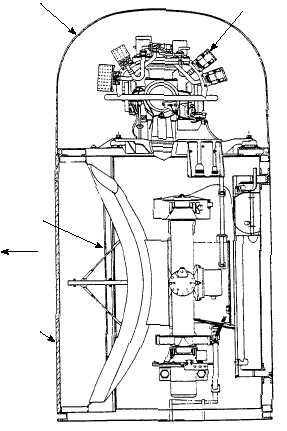Acquisitioning System for the SEASPARROW
missile system.
Control Group
The Control Group provides computer control for
an equipment group, processes target detections to
develop and maintain a track file, and interfaces with
the specific weapon system being used. The Control
Group normally consists of the following equipment: a
computer, data terminal set, magnetic tape unit, and
test set.
Support Systems
The equipment we discussed above composes the
core of the radar system.
To operate properly and
efficiently, it requires a certain amount of support
equipment.
Examples of such equipment include
power supplies (some also have frequency converters),
chilled water systems, and dry air systems. Although
your radar system normally receives 440 VAC directly
from the ship’s primary power source, it has other
voltage requirements that may be stepped up, stepped
down, or converted in order to make the radar fully
operational. High-voltage amplifiers and peripheral
equipment associated with producing RF energy create
tremendous amounts of heat. Chilled water systems
remove excessive heat from such equipment. Cooling
systems may be either liquid-to-liquid or liquid-to-air
types that use either sea water, or chilled water
provided by the ship itself. Another important support
system is the dry air system. Dry air is used for keeping
the internal part of the waveguide assembly moisture
free and to aid in properly conducting the RF energy
being transmitted. The dry air may be either air taken
from ship spaces and circulated through various filters
or dehydrated air provided by the ship. Some systems
use a special gas for their waveguides. An example of
this is the Mk 92 Fire Control System, which uses the
gas SF6 for its Continuous Wave Illumination (CWI)
mode.
These are very important support systems to your
radar. As you know, any system is only as good as its
weakest link. Therefore, you must be sure to maintain
the support equipment as required by the equipment’s
technical manuals and maintenance instructions.
Stable Elements
Hitting a target on a regular basis requires that the
gun or launcher be stable in relation to the target.
Ideally, the platform on which the gun or launcher is
mounted is stable throughout the target acquisition and
destruction cycle. Unfortunately Navy ships, on which
the guns and launchers are mounted, are seldom stable.
In even the calmest sea, they pitch and roll to some
extent. The solution lies in stabilizing the guns and
launchers while the ship continues to pitch and roll.
This is done with gyroscopes (gyros) installed in the
fire control systems.
Gyros provide a stable platform, called the
horizontal plane, as an unvarying reference from
which the fire control problem is computed. The basic
fundamentals and functions of gyros are covered in
NEETS Module 15—Principles of Synchros, Servos,
and Gyros.
In fire control, we call the stabilizing unit a stable
element. As its name implies, the stable element uses a
stabilizing gyro.
The stabilizing gyro is also the
primary reference for navigation of the ship. It gives
the ship a true North reference for all navigational
equipment. The WSN-2 or WSN-5 are examples of
1-11
3A1A1
SEARCH RADAR
RADOME ASSEMBLY
3A1A2
SEARCH
RADAR
ANTENNA
ASSEMBLY
3A1A7
TRACK
ANTENNA
FORWARD
3A1A13
TRACK
RADAR
RADOME
CABLING
DETAILS
OMITTED
FOR CLARITY
NOTE:
LEFT SIDE CUTAWAY VIEW
FCRf0112
Figure 1-12.—Example of a search and track radome.


